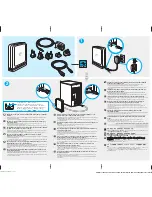
Section 8. Working with Data Files on the PC
summary of the left over values and the Time Series Heading from the
report.
No Date Advance
– When processing a data file from a mixed array
datalogger, if the time stamp uses midnight as 2400 with “today’s” date,
the date function will convert that time stamp to 0000 hours with
“tomorrow’s” date. (This is because the algorithm used by the date
function is based on Windows’ time format, and it does not support a
2400 time stamp.) For example:
Array ID
Year
Julian Day
Hour/Minute
Date Function
Data
Data
10
2002 151
2200
05/31/02
22:00 1.701 193.6
10
2002 151
2300
05/31/02
23:00 1.476 31.99
10
2002 151
2400
06/01/02
00:00 1.123 106.2
At Julian Day 151 (May 31) 2400 hours, the date function produces an
output of June 1 00:00 hours. The date can be stopped from rolling
forward by using the No Date Advance check box. The output will then
be similar to:
Array ID
Year
Julian Day
Hour/Minute
Date Function
Data
Data
10
2002 151
2200
05/31/02
22:00 1.701 193.6
10
2002 151
2300
05/31/02
23:00 1.476 31.99
10
2002 151
2400
05/31/02
00:00 1.123 106.2
Caution should be used when applying the date function and enabling or
disabling No Date Advance, since it is possible to produce an incorrect
date. For instance, using the above example if you were to enter the
following into your select line:
3,edate(“hh:mm”;4;3;2)
with the No Date Advance enabled, you would get the output:
151 22:00
1.701
193.6
151 23:00
1.476
31.99
151 00:00
1.123
106.2
If you were to enter:
edate(“mm/dd/yy”;4;3;2),4,6,7
with the No Date Advance disabled, you would get the output:
05/31/02 2200 1.701 193.6
05/31/02 2300 1.476 31.99
06/01/02 2400 1.123 106.2
No Dashes
– When the
No Dashes
check box is selected, the dashed line that
typically appears under the column headings will not be displayed. This option
affects all output types (PRN, RPT, HTM, and printed page).
No Summary Heading
– When processing data using time series functions
(see No Summary, above), select this option to prevent the Time Series
8-79
Summary of Contents for LoggerNet
Page 2: ......
Page 30: ...Preface What s New in LoggerNet 4 xxvi...
Page 32: ...Section 1 System Requirements 1 2...
Page 44: ...Section 2 Installation Operation and Backup Procedures 2 12...
Page 136: ...Section 4 Setting up Datalogger Networks 4 80...
Page 227: ...Section 7 Creating and Editing Datalogger Programs 7 9...
Page 298: ...Section 7 Creating and Editing Datalogger Programs 7 80...
Page 402: ...Section 9 Automating Tasks with Task Master 9 12...
Page 406: ...Section 9 Automating Tasks with Task Master 9 16...
Page 450: ...Section 11 Utilities Installed with LoggerNet Admin and LoggerNet Remote 11 22...
Page 454: ...Section 12 Optional Client Applications Available for LoggerNet 12 4...
Page 462: ...Section 13 Implementing Advanced Communications Links 13 8...
Page 482: ...Section 14 Troubleshooting Guide 14 20...
Page 570: ...Appendix F Calibration and Zeroing F 16...
Page 578: ...Appendix G Importing Files into Excel G 8...
Page 579: ......
















































